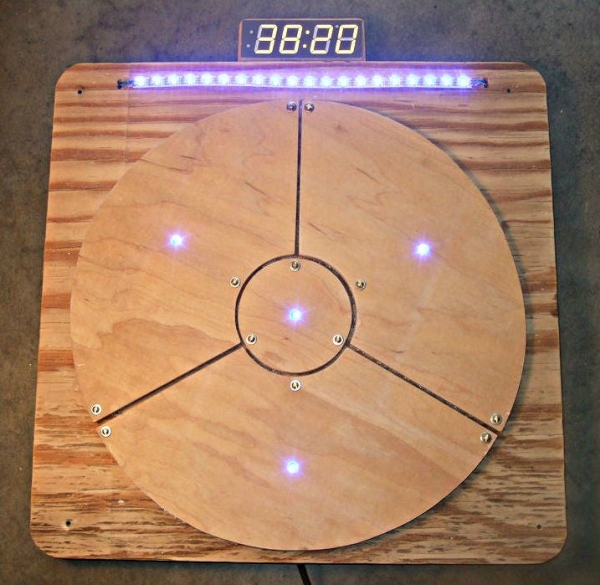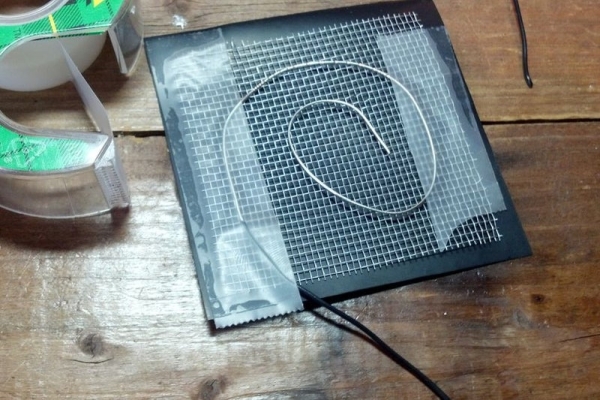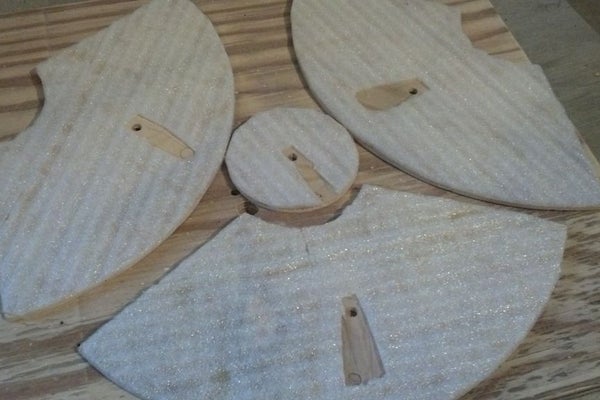
This is a fun and pretty easy project that I built as a Christmas present for my kid who loves throwing things. Watch the video to see what it can do.
It’s built out of a regular Arduino UNO, pressure sensors made from velostat, and RGB LED strip, and 7 segment LED display.
Source code for the games is available on github.
Enjoy!
Step 1: Gather Materials
Materials List:
- 2’x2′ sheet of 1/4 inch luan for the target segments
- 2’x2′ sheet of 3/4 inch faced plywood as a backing board.
- a sheet of Pressure-Sensitive Conductive Sheet (Velostat/Linqstat) for the pressure sensors (http://www.adafruit.com/products/1361)
- any old 5v arduino of your choosing (I used an uno)
- a big 7 segment display (http://www.adafruit.com/products/1269)
- a strip of 24 individually addressable RGB LEDs (http://www.adafruit.com/products/1461)
- some solid core wire
- 4 1K resistors
- some thin foam or thick cloth to act as a shock absorber. (1/8″ foam used in construction to separate 2by material from concrete available at any building supply works great)
- fine metal mesh (like from a screen door, though should be metal, not plastic)
- scotch tape
- small brass screws and washers for attaching the target to the backer board
- Female headers to make connectors to plug into the Arduino and the 7 segment LED display. (http://www.adafruit.com/products/598)
- 2 power supplies, one for the Arduino (9 or 12v) and one 5volt for the LED strip. (The arduino 5v vcc doesn’t provide enough current for the LED strip).
- Section of 2×2 pine or other wood for legs of the backer
Tools:
- Jigsaw for cutting out curves in the target backer board
- Pull saw or other fine saw for cutting the target pieces
- Hole-saw for cutting the center target piece
- Hand saw or circular saw for cutting the backer board
- Sand-paper or orbital sander
- soldering iron
- hot-glue gun
- drill with various sized bits
- Razor blade or utility knife and scissors for cutting foam shock absorber
Step 2: Measure and Cut the Target

Measure:
On the luan, draw a circle. (I used a mixing bowl as my template that happened to be a good size, about 16″ in diameter).
Then find the center of the circle. I used this technique: https://www.instructables.com/id/How-to-find-the-ce…
Next divide the circle into three equal parts like a Mercedes Benz logo. I used this technique: http://www.popularwoodworking.com/woodworking-blog…
Cut:
Before you cut the pieces, mark them so you can get them back together as they originally were. Your cutting won’t be perfect, but it all works fine if the pieces remain in the same relative order.
Now, use the jigsaw to cut out circle. It helps to clamp the circle on your work-surface and go slow.
Then use the hole-saw to cut out the center piece of the target.
Now, use the pull saw to cut the three other pieces of the target. Again, clamping the luan as you cut makes this much easier.
Finally use the sander to clean up the cut edges of the target.
Drill:
Drill holes in the center of each target piece to a size slightly bigger than a single LED on your LED strip.
Step 3: Cut and Mark the Backer Board

Cut your 3/4″ plywood to a size bigger than your target. I cut mine to 20″x20″. Then I used a tin can as a template to round off the corners, and I used the jig-saw to cut those edges off. This makes it look nicer. Use the sander to clean up edges of the plywood.
Now use the same circle template to draw the target circle on the backer board. Remember not to do this on-center as a the LED strip goes across the top of the board. Place the target segments on the board in their final position separating each piece from the other by about 1/4″. Poke a pencil through the LED holes to mark where the sensors will be attached to the backer board.
Finally, with the target pieces in place, drill pilot holes for the screws that will attach the pieces to the backer board, and then drill bigger holes in the target pieces (but not in the backer board) so that when the screws are in place the target pieces can depress easily and won’t be hindered by the screws.
Step 4: Build and Install the Pressure Sensors

To build the pressure sensor:
- cut 4 equal size squares of the velostat and 8 equal size squares of the wire mesh about 1/2″ smaller than the velostat squares.
- cut 8 lengths of the solid core wire and strip about 4 inches off the end of each
- curl the stripped part of the 8 wires into a spiral.
- now make a sandwich that goes: mesh, curled wire, velostat, curled wire, mesh. It’s easiest to do this one side at a time by placing the curled wire on top of the velostat, and the placing the mesh over that, fixing them all in place with scotch tape, then flipping it over and doing the same.
To install the sensors:
- Place them over the marked LED holes from the previous step
- For each sensor, mark a spot where you will drill a big hole for the sensor wires (as well as the LED strip leads) to pass through to the back of the board. For the center target piece make sure this mark isn’t near the pilot holes you drilled from the previous step.
- Take the sensors off, and drill the holes.
- Warm up your glue gun, put the sensors back in place, this time passing the wires through the drilled holes. Use just a tiny bit of hot-glue on each corner of the pressure sensors to fix them to the backer board.
Step 5: Install Shock Absorber on Target

The back of each of the target pieces has a thin layer of foam to spread out some of the impact of the balls on the pressure sensor and to protect the LEDs and their wires.
- Cut out foam pieces the same size as the target pieces.
- Hot glue them onto the back of the target pieces but don’t get any glue near the center of the pieces where the LEDs go, nor along where you will route the LED wires toward where the leads will go through the hole in the backer board.
- Using a razor blade or utility knife, cut out channels in the foam for the LEDs and their wires.
Read more: Das Blinken Bonken! an Arduino Ball Throwing Game Platform.
